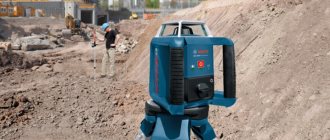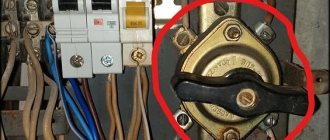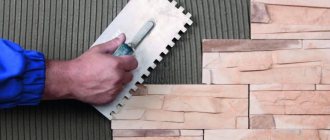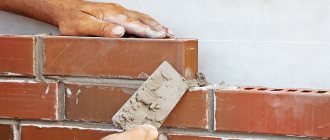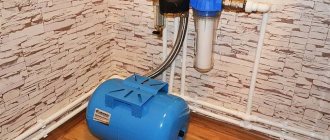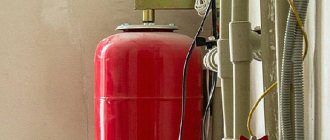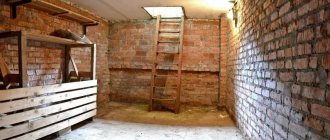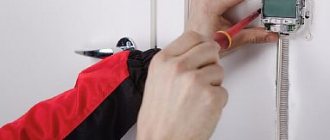A laser level and a laser level are similar meters, but there are differences between them. Today, these two devices replace such well-known construction devices as the water level and the vertical plumb line and are widely used for repair tasks. Let's look at the characteristics and features of a laser level and a level to understand what is their difference.
What is a rotating laser level and what does it mean?
If previously a fishing line with a weight at the end was used for measurement, today a specialized device is used to measure the difference in heights of several points. This meter, which is also called a laser plane builder, is used not only before the start of construction and repair work, but also after its completion. Quality control of the work performed can be identified in a matter of seconds and without the need for manual measurements.
Structurally, the tool is a compact device that is used in conjunction with a stand - a tripod. To construct planes in the design of the tool, a light indicator is used - a laser beam. Before you learn the details of the operating principle of this tool, it should be noted that plane meters are classified into three types:
- Optical are the simplest and first levels to appear. Their advantage is their affordable price, but there is also a drawback - you need to know how to use them, since measurements are made manually through a lens system
- Electronic - devices that differ from optical ones by the presence of an option for storing data when taking measurements
- Laser - compared to optical and electronic, where measurement accuracy depends on the human factor, laser levels are highly accurate and reliable, which is why rotary levels are in particular demand among builders of various fields
Laser levels include a rotary level. By using laser levels, you can construct planes at a distance of up to 100 meters, while optical and electronic levels allow you to measure at a distance of up to 20 meters. The use of additional optical equipment makes it possible to measure with a laser instrument at a distance of up to 400 meters and even up to 1 km.
This is interesting!
Rotational means rotating, through which a plane is built.
How does a laser level differ from a level?
The word level comes from the concept of leveling, which in turn is an important stage in geodetic work. It allows you to study the shape of the relief and determine the terrain parameters by plotting the heights of certain points. Such products are widely used in the design of geodetic structures with maximum accuracy, installation of power line poles, and forecasting the subsidence of objects. That is, these are high-precision meters. For example, the error of a level can be no more than ±0.1-±0.3 mm/m. Moreover, the higher the cost of the level, the clearer its readings will be.
The laser level may be less accurate. This is quite enough for domestic use, construction of country houses, laying tiles, installing screeds and more. The level will also help when positioning sockets and fuses. Cost does not affect the accuracy of this level of data as much, but a more expensive level can perform additional functions.
There are also some design differences. For example, the level provides:
- spotting scope;
- source of radiation (laser);
- optical system, due to which planes and lines are lined up;
- mechanism responsible for alignment in space;
- control mechanism.
The level has a design of:
- laser emitter (there may be one or more);
- control mechanism;
- leveling systems.
That is, a laser level is a more highly specialized and accurate device, and the level can be called more household (although there are also professional models). However, in a hardware store, a simpler device may sometimes be called a level.
What is the operating principle of a rotational laser builder?
The price of laser rotary levels is always high, however, this device has a simple operating principle. The operation of the measuring level is based on the construction of a plane due to the glow of a bright LED. The rotary level received this name due to the construction of a 360-degree horizontal plane.
With a rotary device, you can build a horizontal plane over the entire area of the room, which is an immediate advantage. The ability to construct a plane along the entire perimeter of the room is achieved by moving the beam by rotating it. This is achieved through the use of an electric motor, which drives the laser beam. Depending on the place of application, the devices can be street or geodetic and construction. They differ not only in cost, but also in the degree of protection from dust and moisture. While a geodetic level can be used for measurements indoors, measurements cannot be taken outside with a construction tool for interior work. This is due to the following reasons:
- A low degree of protection will lead to the ingress of dust and moisture leading to rapid failure of the tool.
- Inability to detect projection due to low beam illumination
- Low projection range, which does not exceed 20 meters
The rotary device has not only a horizontal plane construction, but also a vertical one in the form of a point. However, this option is not available on all models of laser levels. To construct a vertical plane, the same laser beam is used, only for this purpose the device is installed on the side wall.
This is interesting!
The further the level is able to project the plane, the higher the error rates.
The best magnetic levels
When working with metal structures, magnetic levels are a great help. Their characteristic feature is internal magnets, which allow the tool to be vertically attached to metal surfaces.
Kapro "Torpedo" Plumbsite 241-23
4.8
★★★★★
editorial assessment
87%
buyers recommend this product
The hybrid model has a removable suspended mini-level 23 cm long. This design allows you to measure deviations from a given surface angle. It is possible to adjust one of the eyes in the range from 0 to 180 degrees. Error 0.5 mm/m. The cost of the device is slightly above 1000 rubles.
Advantages:
- the presence of three polyacrylic flasks;
- additional linear mini-level;
- checking the angle of inclination of the plane;
- adjustable bulb;
- high accuracy.
Flaws:
- the price is high;
- fragile plastic.
The magnetic level is securely fixed on any metal surface, which makes work easier. In tight spaces, you can simply remove the central bulb and take measurements using it.
FIT with three eyes
4.7
★★★★★
editorial assessment
85%
buyers recommend this product
Due to the presence of three eyes in this model, it is used to control horizontal and vertical surfaces, as well as slopes. Due to the built-in magnet and lightweight body, the device adheres well to metal. Measurement error - 0.1 mm. The cost does not even reach 500 rubles.
Advantages:
- reliable fixation in horizontal and vertical positions;
- surface tilt angle control at 45 degrees;
- compact size and easy storage;
- low price.
Flaws:
- no rubber plugs on the sides
- lack of adjustment.
This miniature device, weighing only 60 grams and dimensions 230x40x15mm, is perfect for working in confined spaces.
How to use a rotary level
To take measurements with a rotary level, you will first need to install the device correctly. It is mounted using a tripod or rod (indoors), and before turning it on, it is imperative to level it. The principle of leveling is to align the level with the water level built into the design of the instrument. The high-precision meters also additionally have an automatic adjustment option.
After setting up the location of the device, you can start turning it on. After switching on, the LED lights up, the beam of which can be red or green. At the same time, the movable head in which the LED is located rotates. If the location of the tool changes, you must first repeat the leveling procedure.
This is interesting!
A linear laser level is capable of constructing horizontal and vertical planes using a special system of prisms, but such a device is not capable of constructing planes at a long distance, unlike rotary ones. That is why point and linear levels are used for interior work, and mainly rotary or rotating devices for exterior work.
Best bubble levels
Bubble levels are popular because of their simplicity and low price. The air bubble in special flasks is a sensitive and quite precise element. When it is in the central part of the ampoule, the surface is considered smooth.
If you go to the side, there is a slope. There are usually three ampoules: for horizontal and vertical directions, as well as at an angle of 45 degrees. The measurement error of such an instrument is 0.5-1 mm/m. The length of the levels can range from a few centimeters to 4 meters.
Stanley 0-42-130
4.8
★★★★★
editorial assessment
89%
buyers recommend this product
See review▶
This bubble level can be carried in your pocket or clipped to your belt. It has a simple design of vertical and horizontal capsules, a V-shape and a magnetic base. The model is convenient to use for work in hard-to-reach places. The cost of the level is from 500 rubles.
Advantages:
- small weight and dimensions;
- magnetic base;
- two capsules with easy-to-read readings;
- cast body.
Flaws:
- only basic functionality.
For a pocket level, the presence of ampoules for horizontal and vertical surfaces is a big plus. The bad thing is that they are completely open and can be accidentally damaged.
Topex 29C883
4.6
★★★★★
editorial assessment
84%
buyers recommend this product
A type of bubble structures are pipe levels for monitoring utility systems. This model has as many as five ampoules. They are located at different angles: 0, 1.5, 3.5, 45 and 90 degrees. The device features a convenient grip hole. Measurement accuracy - 0.5 mm/m. Due to the fact that the ampoules are located at different angles, it is easy to align the drain pipes at the desired angle.
Advantages:
- bright and easily readable bulbs;
- presence of 5 different ampoules;
- corrugation “under the pipe”;
- cost 350 rubles.
Flaws:
- lack of magnet;
- Problems with fixation - sometimes it falls.
This level is suitable for installing sewerage and water pipes.
Stabila Pocket Electric18115/17775
4.5
★★★★★
editorial assessment
81%
buyers recommend this product
The compact product, 70 mm long, has a special recess on the body. This configuration allows you to simply and conveniently use a screwdriver when fastening structures. The error level is only 1 mm per linear meter. Cost 680 rubles.
Advantages:
- displacement of the calibration flask;
- convenient operation with a screwdriver;
- the presence of a powerful neodymium magnet;
- compact sizes.
Flaws:
- control only horizontal measurements;
- plastic case.
The model is ideal for electrical installation work. With its help, installing sockets and switches of insulated wiring, as well as screwing in fasteners, takes a minimum of time.
READ ALSO
12 best saw blades
What are the advantages and disadvantages of rotation levels?
Compared to linear and point levels, rotary levels have many more advantages. Among the advantages of rotary instruments, it should be noted:
- Construction of horizontal and vertical planes at 360 degrees, which is achieved due to the mobility of the laser head
- High accuracy of readings, since instead of a system of prisms, which increase errors, the construction of a plane is carried out by rotating the head with a laser at high frequency
- The measurement range is up to 1 km, so the tool is popular not only among builders, but also among surveyors, designers and workers involved in landscape studies
- Determining the beam on the projected surface using a special remote control
The presence of so many advantages makes the device in question an immediate favorite among its peers. However, before you buy a laser rotation level, you should understand the existing disadvantages. The rotational meter also has disadvantages, and here they are:
- High price - a rotary device costs the same as three linear levels. Such a high cost is due to the use of an electric motor in the design, as well as a complex mechanism for rotating the head with an LED
- Impossibility of simultaneous construction of vertical and horizontal planes. There are levels in which the horizontal plane is projected due to a rotating head, and the vertical plane through a system of prisms, as in linear devices. Most levels are also equipped with point lasers that allow you to build a projection on the ceiling
Taking into account all the advantages and disadvantages, it remains to make a conclusion about the need to purchase such a device. It is not necessary to buy such a tool if you are working indoors, but without it it will be difficult to cope with outdoor measurements. That is why it is recommended to purchase a rotary level for all craftsmen and workers whose field of activity involves measuring work on the street.
This is interesting!
The rotary device not only has high measurement accuracy, but it can also be used in rainy or sunny weather. The laser beam is not distorted by water and sunlight, so measurements are accurate and clearly visible.
Main types
To choose the right laser level, you need to know about the existing types of these devices. Manufacturers offer:
- linear levels (so-called crossliners). A larger or smaller plane is formed, the size of which depends on the scanning angle of the device. They form a line only in the direction in which they are turned. Crossliners are well suited for simple construction and finishing work;
- rotary levels. Thanks to the special system that is implemented in them, they produce laser planes turned º. The same system leads to a significant increase in the cost of rotary levels in comparison with linear models. They have a long range, much greater than that provided by crossliners. Such devices are most often used on construction sites.
What technical parameters do rotation levels have?
Depending on the technological tasks set, the leveling process involves taking into account the following technical parameters of the measuring level:
- The light emitter is an LED through which the plane is projected. The quality of the LED determines its glow, energy consumption, and the presence of the heating process. In the devices under consideration, it is very important to use high-power LEDs, since conventional light emitters are not capable of projecting planes over long distances. There can be 2 or even 3 light elements in the design
- The presence of a mechanism by which the position of the tool is adjusted. Expensive devices are equipped with a system for automatically setting the deflection angle, since this mechanism affects the cost accordingly. The angle of automatic position adjustment does not exceed 5 degrees, so in any case, all levels have built-in water levels to adjust the position of the laser level
- Optics - thanks to optics, it is possible not only to project the beam over long distances, but also to make it of the same thickness
- Control system - unlike point and linear ones, rotary ones have great functionality. These are different options that allow you to build horizontal, vertical and point planes
- Method of energy consumption - all devices are portable or autonomous, that is, they operate from built-in batteries. These can be either regular AA batteries or self-contained lithium-ion batteries. Almost all rotary levels from well-known manufacturers Hilti, Bosch, Condtrol, Stabila and others have removable lithium-ion batteries. Some models operate from two power sources - the motor and the LEDs.
- Rotation speed of the moving head - expensive models of devices have regulators through which you can set the speed of rotation of the head
- Additional devices are special glasses, targets and remote controls in the form of receivers. These additional devices allow marking over long distances, while improving the quality of measurements
The technical description for each model of a rotary level indicates such data as the magnitude of the error or measurement accuracy, the distance, as well as the color of the laser beam and the possibility of using the device to construct a 360-degree vertical projection. Having an idea of what a laser rotation level is, it remains to figure out how to choose this measuring level correctly.
This is interesting!
It makes no sense to compare point and rotary levels, since although they have the same purpose, the principle of constructing planes is very different. Before choosing one or another device, you must first decide what you plan to measure and where the work will be performed - indoors or outdoors.
Which building level is better to buy?
There are six types of such devices on the market:
- Bubble or magnetic levels are optimal for home use. They are used to install windows or lay tiles.
- Thanks to their advanced functionality, electronic ones are suitable for serious home repairs and construction sites.
- Digital inclinometers provide highly accurate measurements and display them on a display.
- Pipe levels are used to level gas or water pipes.
- Hydraulic levels are used for floor screeding, when installing suspended ceilings and installing reinforced concrete blocks.
- Laser is chosen for larger scale construction work. They will help in marking walls, structuring the floor, conducting communications, etc.
Professional builders often prefer foreign brands such as Stabila, Matrix, Kapro or Stanley. But for those who want to save money, reliable domestic manufacturers are quite suitable, for example, a leading supplier of tools.
Recommendations: 13 Best Measuring Tapes
13 Best Laser Levels
15 Best Laser Rangefinders
How to choose a rotating laser level - detailed instructions
Few people pay attention to additional criteria for choosing a laser level, since price plays a major role in this matter. To buy a high-quality device with options that will be useful, you should first consider the following parameters:
- The magnitude of the error - the higher, the lower the accuracy of the measured readings. No matter how accurate the level is, and no matter how much it costs, all meters have an error, and there is no escape from it. Another thing is the permissible error value, which practically does not play a big role on the quality of measurements. The normal and permissible error in levels is 0.5 mm/m. If the level has an error of 1 mm/m, then it is not recommended to buy such a tool
- Technical parameters of the beam wavelength. The normal wavelength is 635 nanometers, and this value indicates the quality of its visibility at a long distance. It is precisely due to the wavelength that the beam is determined using a special receiving panel
- Measurement range - the longer the measurement length, the more expensive the instrument. It is not rational to buy a rotary device for projecting planes over long distances over 200 meters for your home. Levels that project a beam over a distance of up to 1 km are in demand among designers, surveyors and engineers
- Power - it is better to choose models that run on built-in lithium-ion batteries. They not only hold the charge longer, but also do not affect the quality of beam convergence. Conventional batteries affect the quality of the laser glow as they discharge.
- Availability of auxiliary equipment. These are control panels, one of which is a receiver, and the second is used to control the device from a distance. This is convenient when you need to determine the projection on a distant surface. To do this, you need to align the device, and then move to the surface to be measured, and then turn on the level using the remote control
- Protection from dust and moisture. The possibility of using the device outdoors depends on this indicator. Most levels can only be used in dry weather, but there are levels with a degree of protection IP 54 that can be used even in rain
- The ambient temperature at which the equipment can be operated. Outdoor instruments usually have a mark ranging from +50 to -20 degrees
- Availability of a self-leveling option - this option is auxiliary and only affects the quality and accuracy of the measurements obtained
- Productivity - you need to pay attention to rotational levels from well-known brands. Buying a tool from an unknown manufacturer and at a reduced cost is a big risk of irrational investment. Such levels can quickly fail, so it is recommended to read reviews for each model first
- Equipment - the presence of additional equipment will not only simplify the use of the tool, but will also expand its functionality. Such equipment includes cases for storage and transportation, tripods, remote controls, glasses, surveying staffs, receivers, chargers
Based on the above recommendations, you need to choose new rotational laser levels with a rotating LED. Let's look at some good and worthwhile rotational level models that are really worth the money.
This is interesting!
Reviews show that the green beam is better visible compared to red.
There are no fundamental differences
Both the level and the level build laser planes designed for precise work. The first term, as a rule, refers to entry-level devices that have a simple design and are the most affordable. Simple intuitive operation and small dimensions allow the devices to be used in everyday life.
Laser levels, as a rule, are called professional-class equipment - complex, relatively expensive and maximally functional. In most cases, it is used on construction sites.
Rotary laser levels best models rating
Rotary levels belong to the category of professional measuring instruments that have low error rates and high measurement accuracy. Let's look at several models of rotational levels that you should pay attention to when choosing. These devices have positive reviews.
- Bosch GRL 300 HVG Set and DeWalt DW 079 PKH. These are the two most popular devices that are distinguished by their high quality and functionality. Both levels have the ability to automatically level up to 5 degrees. The Bosch version is capable of projecting a plane up to 150 meters with a receiver, and the DeWalt model up to 300 meters. The accuracy or error value is 0.1 mm/m, the wavelength of the Bosch model is lower 532 mm than the DeWalt 635 mm. The models also differ in the color of the laser beam, and you can buy them for 90 thousand rubles
- Bosch GRL 250 HV - this device has a range of 250 meters without using a receiver, and the error is 0.1 mm/m. The color of the laser beam is red, and the number of LEDs is 2. The level has a degree of protection IP66, and its cost is slightly above 50 thousand rubles
- Ada Cude 360 is a popular option that costs from 10 thousand rubles. It has an error of 0.3 mm/m, and also operates at temperatures from +45 to -5 degrees. The range of the level is 20 meters
- Ada Topliner 3x360 - costs from 30 thousand rubles, but the device is simultaneously capable of constructing planes in different directions at 360 degrees. Its error is 0.2 mm/m, and the measurement range is up to 20 meters without a receiver
It is also necessary to pay attention to models from such manufacturers as Hilti, Condtrol, ADA, Infiniter and others. There are inexpensive models starting from 9 thousand rubles, and there are also devices whose cost reaches 200-300 thousand rubles. When purchasing a rotary laser level, you need to calculate how quickly this tool will pay for itself, which will ultimately help you make the right choice.
Several reasons to buy a laser level or level from us
The group has been operating on the market for more than 10 years. During this time, we studied in detail the range of geodetic equipment and identified the best manufacturers with whom we organized cooperation. Here you will find laser levels and levels from such brands as:
- Spectra Precision. It was this manufacturer that first introduced an industrial rotary level to the market. Later, the company developed devices with prismatic laser scanning;
- Leica. Devices of this brand are an excellent combination of high functionality and affordability. Their design includes modern LEDs that generate clear and bright beams. Leica rotary laser levels deserve attention with a high degree of protection from adverse external conditions, efficient servos and the ability to use different power sources;
- Vega. Laser levels of this brand create excellent visible planes and ensure the highest precision of work. They use rotating prisms for circular leveling, compensators for leveling and other useful devices.
Our company is an authorized partner of many manufacturers of geodetic equipment. When making a purchase from us, you will be confident in the original origin of the device you are purchasing and the absence of problems with its warranty and post-warranty service. In addition, partnerships with manufacturers and the absence of intermediaries allow us to keep the prices of laser levels and levels at an affordable level. By purchasing these devices from us, you will not overpay!
Functional Features
As mentioned above, the level has a large number of functions, especially when it comes to the rotary model. The level itself rotates in a plane, and at the same time has a single point of support, and then from 2 to 4 points along the entire circumference in the area of the beam. Thus, it is customary to distinguish between point levels that can project both 3 points and 5 multidirectional points.
The laser level, on the contrary, does not have its own fulcrum, but only two along the length of the projected beam, which begin and end it, respectively. The level can project horizontal, vertical, or both lines at the same time. What comes of the above? Both devices belong to the category of measuring instruments. The difference is simply colossal, but, in fact, the level itself can become a logical, and quite functional, replacement for a laser level.
How to check
The laser level is checked in 2 directions:
Horizontal
Verification is carried out when the measuring instrument is installed on a flat surface (at least 20 cm high). The laser level must be turned on in automatic leveling mode. After this, a laser beam will appear in front of the level.
Direct the rays at one of the walls and wait 30-40 seconds. On the surface of the wall, mark with a pencil this place A, where the lines intersect. Rotate the tool 180 degrees. After this, the level performs a self-leveling process. After 30-40 seconds, on the surface of another wall you can mark the intersection of the rays (point B).
After this, move the tool to another wall without turning it around. Turn it on in self-leveling mode and wait 30-40 seconds. The level must be adjusted so that the intersection of the laser exactly coincides with that previously marked during the second measurement (point B).
At the last stage of verification, the level must be carefully rotated 180 degrees, turned on in automatic leveling mode and after some time mark the intersection point of the laser beams on the wall surface. It should exactly coincide with point A, previously marked during testing.
It is possible that during leveling the points on the wall surface will not coincide. This means that there is an error in the level's operation. The acceptable error value is considered to be no more than 2 mm, provided that the distance between the walls is 10 meters.
Which laser level to choose: characteristics and types, which one to buy
In the practice of private construction, in the vast majority of cases, the installation of structures or finishing is carried out with strict adherence to the vertical and horizontal main lines and planes. This, firstly, is largely predetermined by the requirements for strength, stability, durability, and, by and large, the safety of the buildings or structures being erected, and secondly, strict adherence to “geometry” gives buildings, premises, and finished finishing an emphasized accuracy.
Which laser level to choose?
Until recently, the main control tools of the builder were a plumb line, a simple spirit level, a water level, a square, etc. The acquisition of a high-quality construction bubble level was considered a great success. But today the situation has changed radically - laser equipment is increasingly coming to the aid of builders, making it possible to carry out markings with the highest accuracy and carry out constant monitoring during the work. And such a tool is already becoming not only the privilege of professionals - more and more home craftsmen want to have it in their working “arsenal”. Therefore, it is quite natural for the query that is so popular in Internet search engines: “which laser level to choose.” Let's try to understand this in more detail.
Principles of design and operation of laser levels (levels)
So, a laser level is an optical electromechanical device that visually projects lines, points or planes located strictly vertically, horizontally or at a certain angle set by the user onto building structures or surfaces.
The use of such devices provides many advantages:
- Measurements and markings are carried out with high accuracy, usually not exceeding fractions of a millimeter per meter, which is hardly achievable using traditional instruments.
- Laser devices quickly prepare for work and are able to provide the necessary points, lines or projections of planes immediately onto a large construction or repair site.
- No special qualifications are required for the worker - the operation of such devices can be mastered very quickly.
- The use of laser levels allows you to do it on your own in many cases without assistants.
- The time required for marking operations is significantly reduced, up to 40÷60%.
Basic design elements of a laser level
The variety of modern models is very wide.
Models of laser levels are distinguished by a very wide variety. However, they all consist of several systems and mechanisms arranged in one body and interacting with each other. These include:
— source of light radiation;
— optical system;
— installation mechanism and self-leveling device;
— power supply;
— manual or remote control of the device;
— a housing that ensures the protection of the device from mechanical damage, moisture, and dust.
- The source of light radiation in such devices is always powerful LEDs. These semiconductor elements are capable of creating a high-density monochromatic flux of a certain wavelength, without giving off too much heat, without consuming a lot of electricity, and without fear of accidental mechanical damage.
Laser levels with red and green beams
As a rule, modern devices of this class use two types of LEDs. The first ones, with a light wavelength of 635 nm, emitting a red color (with a slight yellowish tint) are still on most laser levels. In new modifications of devices, a gradual transition to LEDs with green radiation, a wavelength of 532 nm, can be seen. This frequency is closer to the peak of light perception by the human eye, and lines “drawn” at this level are more visible, which is especially important in sunny weather when working outdoors.
Stayer laser levels prices
Stayer laser levels
True, the design of devices with a green beam is somewhat more complicated, they are more energy-intensive, and are significantly more expensive.
- An optical system is necessary to focus the beam and give it the desired direction and configuration - from a point to a scattered flat flow in a certain sector, giving a straight line on the obstacle.
The optical design is a combination of prisms and lenses. It can be stationary, motionless, or have a rotating head - this will be discussed below.
The accuracy of the laser level itself and the visibility of the points and lines it creates directly depend on the quality of the optics.
- The installation mechanism may differ for different models.
Some inexpensive devices will have to be set manually using bubble levels.
The simplest laser levels are, in fact, a familiar bubble level into which an optical system with an emitter is built-in. Such a device must be accurately installed on a tripod, and by rotating the adjusting screws, the exact horizontal position must be achieved. Only then can you start working.
Laser levels with a self-leveling system are more convenient in this regard. Before starting work, they are also installed on a tripod or on a surface (wall bracket, etc.). They usually also have adjustment screws (feet) and bubble levels. But high precision during installation is not required. If the deviation from the horizontal does not exceed the specified value (usually from 3 to 5°), then a special pendulum or gyroscopic mechanism will make the necessary corrections itself, and as a result the optical unit will take the required position.
More advanced models are equipped with a self-leveling mechanism
Moreover, even during operation, the stabilization system will monitor the correct position and compensate for possible small deviations. If the shift is too significant, exceeding the self-regulating capabilities of the device, an audible or visual signal will be given that intervention from a specialist is required to reinstall, for example, on a more stable base.
Most modern laser levels are already produced with a self-regulation system of varying degrees of complexity and accuracy.
- The laser level can be powered from regular batteries (for simple household-grade models) or from nickel-cadmium (nickel-metal hydride) batteries, which ensure operation of the device for a fairly long time - up to 10 hours or more. Naturally, in this case, the laser level kit must include an appropriate adapter for regular recharging of batteries.
- The controls for a laser level are usually simple, and consist of a panel with several buttons that enable certain functions, and indicators that indicate, for example, the status of the device or the charge level of power supplies.
Many professional-class models are equipped with remote controls. This is a very convenient option if, for example, you have to carry out work alone, especially on a large construction site.
When working on large sites, remote control becomes a useful option.
Laser levels are available with a built-in rangefinder function - “electronic roulette”. Such products have a digital display panel on which measurement values are displayed with an accuracy of several millimeters.
- Most modern laser levels are housed in a housing made of impact-resistant plastic, protected from external influences, and are usually also supplemented with damping rubber pads - to reduce the likelihood of damage to the device due to accidental impacts during construction or repair conditions.
Types of laser levels
All devices of this class can be divided into three groups:
- Point laser priors are static axis builders.
- Static line builders.
- Rotary plane builders.
Static axis builders
Such devices belong to the category of the simplest. The lens system provides an output of a similar level of thin direct rays that are projected onto surfaces into points.
Marking a horizontal line with a dot level
The absence of complex prismatic optics ensures maximum light intensity, and usually devices of this type have a long range.
Number of beams may vary
The number of rays created may vary. In simple devices, which are often called laser plummets, there are three of them - directed forward, strictly horizontally, and two vertical, down and up, at the zenith and nadir. It is very convenient when marking, for example, frame structures for interior partitions, when it is necessary to achieve a perfect match between the lines on the ceiling and the floor.
More advanced models may also have rays directed left and right, naturally lying in the same horizontal plane as the front one. This gives additional advantages in work, for example, when carrying out marking work indoors.
Axis builders are convenient when working on the ground or in very large rooms; when it is necessary to draw one horizon line at a considerable distance.
Static line (plane) builders
Such devices are often called cross-liners. The beam from the source, passing through special prisms, is scattered and turns into a flat narrow stream, which is projected on surfaces in the form of lines. Most devices provide the ability to simultaneously transmit flow in the vertical and horizontal planes, so that two lines are projected on the surfaces at once, vertical and horizontal with a clear crosshair.
Two narrow flat light streams define a perpendicular intersection of planes
Such devices are extremely convenient when performing marking or finishing work - the master can constantly visually monitor the correctness and evenness of the operations being performed.
Typically, such laser levels use several LEDs and prisms, which is why they are often called multi-prism. The number of planes created can be different - from one crosshair to several (marking is carried out on several walls at once), and in addition, zenith and nadir points can be projected.
Laser levels of this type are very convenient when performing finishing work.
An important characteristic of devices of this class is the sector angle in which the plane is projected. Usually it is at least 120°, although there are modern models in which this figure reaches 160° or more. Well, the most advanced laser levels are capable of completely closing the projections of three planes they create, that is, they work at all 360°.
Some devices allow you to completely close the lines in a circle
The disadvantages of static builders include the fact that the use of prism optics and dispersion of the flow significantly reduce its intensity, and at considerable distances or on a bright sunny day, the created projections can be difficult to see, which will require the use of special additional accessories - this will be discussed later.
Nevertheless, such devices are extremely convenient and are extremely popular among professionals and amateurs, especially those involved in interior decoration.
Rotational plane builders
When working on open construction sites or in large areas, laser plane builders of the rotational type are the optimal choice to create a common horizon.
The rotating head turns the beam into a plane
The absence of prismatic scattering makes it possible to obtain a beam of maximum light intensity, and the plane is created by rotating the emitting head relative to a strictly vertical axis.
Typically, such devices belong to the professional class. Their beam transmission range can reach tens, and when using special receivers, even hundreds of meters. On a vast construction site or in a large room, it is possible to create a single horizon, thereby ensuring the simultaneous independent, diverse work of several teams.
Such devices are indispensable in large work areas.
Some “advanced” models are capable of creating both horizontal and vertical planes at the same time - they are equipped with two rotating heads.
The rotation speed of the emitter can usually be adjusted, for example, from 10 to 600 rpm.
Such laser levels (levels) belong to the most expensive category, and are not widely used in the practice of individual construction - it’s just that their capabilities in such conditions largely remain unclaimed.
What criteria should you follow when choosing a laser level?
If a decision is made to purchase a laser level, then the potential owner should already have a clear idea for what purposes he will need this tool. Such devices are quite expensive, and as their functionality increases, the price naturally increases sharply. This means that it would not be very reasonable to pay extra money for a laser level, the functionality of which will simply remain unclaimed.
When choosing the required model, you should be guided by certain criteria.
Device range
For different models it can range from several meters to several tens. Naturally, this also affects the rate of battery consumption. If you purchase a device to perform construction and finishing work in a house or apartment, then you should not chase a special range. It’s another matter if large-scale work is planned on the ground.
The range is indicated in meters. Here you need to be careful - sometimes manufacturers mean the radius, sometimes the diameter of the zone in which lines or points can be projected.
The laser radiation receiver allows you to dramatically increase the range of the device
If significant distances are required, then you should pay attention to whether the device is equipped with a special laser radiation receiver - this can significantly increase the range. It also happens that the receiver is not included in the kit, but the technical documentation reflects the possibility of using it, and the range parameters are shown with and without it, for example, 50/100 m.
Laser type
This has already been mentioned. The green beam is considered optimal, as it is closest to the maximum perception by the eye. Devices with a red beam are less expensive, but can create problems when working in conditions of bright natural radiation. The solution is to use receivers or special glasses that improve the visibility of the lines or points being created.
With special glasses, dots and marking lines will be much better visible
By the way, glasses, to a certain extent, will also serve to protect the retina from accidental direct hits from a laser beam. Of course, modern devices do not pose an excessive threat to health, but still they usually belong to class 2, that is, they cannot be considered absolutely safe.
Laser devices of the third class, with an increased range, should be used with extreme caution - their radiation already poses a serious threat to the retina.
Prices for Bosch laser levels
Bosch laser levels
If you purchase a device with red rays, you should also look at the wavelength. 635 nm can be considered optimal, but there are still outdated models in which this figure is 650 nm - even further to the periphery of the visible part of the spectrum.
If the technical documentation of the device does not indicate any information about the class of the laser used, then it is almost 100% a fake and does not deserve any attention.
Instrument error
The more accurate the device, the better, of course, but, alas, there are no absolutely ideal ones.
The error is usually indicated in millimeters for each meter of distance from the device. Expensive professional-level models can give an error within 0.5÷1 mm at a 10 m distance. For middle-class laser levels, a completely acceptable deviation can be considered from 1 to 3 mm per 10 m (usually 0.1÷0.3 mm/m is indicated)
Higher error rates are hardly acceptable - the use of such inaccurate instruments simply loses its meaning.
Installation accessories and self-leveling system
Many laser levels require installation on a tripod. It may be included in the kit or purchased separately. If you have to select it, pay attention to the size of the connecting thread - it can be ¼ or ⅝ inches.
It is necessary to take into account the diameter of the threaded connection with the tripod or brackets
It is very convenient if the laser level has the ability to be attached to various brackets - they are often included in the kit. This makes it possible to install the device, for example, on a wall surface or as close as possible to the floor surface.
Some types of brackets and stands
Magnetic fastenings are often provided - the level can be fixed on metal building structures, pipes, etc.
Using a magnetic holder, the laser level can be fixed to metal structures
Of course, the best choice would be a device with a self-leveling system. Its cost, of course, is higher, but it eliminates the possibility of making a subjective error during installation - the system will independently eliminate the existing inaccuracy. The self-adjustment range can be within 3° in relatively inexpensive models, and up to 5° in professional-class devices. If the deviation exceeds the specified values, the system will give an audible or visual (for example, flashing beam) signal.
If lines are set at an angle to the horizontal, the self-leveling system must be disabled
The self-leveling system must be able to be turned off - this is necessary when marking at a certain angle from the horizontal, say, building a staircase or performing original finishing.
Number of rays (planes) created
A reasonable approach by the future owner of the device is important here, and for this it is necessary to imagine the planned scope of application of the laser level. Ideally, of course, the more functional the device, the better, but its cost also increases in proportion to this.
If a multiprism level is selected, then it is desirable that the possibility of selectively switching on and off the created lines be provided. Sometimes extra rays create a lot of inconvenience and can even cause some confusion.
Battery life
This indicator, of course, depends on the quality of the power sources used and the characteristics of the electronic circuit of the device itself. As a rule, this indicator, provided that standard, fully charged batteries are used, is indicated in the product documentation.
It is rare that there is a need for long-term continuous operation for many hours. During breaks in work, it is quite possible to recharge power supplies, but only if nickel-metal hydride batteries are used, which do not have a pronounced “memory syndrome”. If nickel-cadmium batteries are used, they must be used until completely discharged.
A convenient option is the ability to automatically turn off the device after a certain time. For example, if no manipulations were performed, the emitter will turn off after 15–20 minutes and the device will go into standby mode. This allows you to effectively use the potential of power sources.
Parameters for using the device in “field” conditions
If the future owner plans to use the device in outdoor conditions, then you need to pay attention to some operational parameters:
— temperature range at which the laser level can be used. Some products are allowed to be used exclusively at positive air temperatures - from +5 to + 40 °C. If you plan to build in winter, you need to choose a level with a wider range, for example, from -10 to + 40 °C. Exceeding these limits will result in equipment damage.
— degree of protection of the product body. For outdoor conditions where high humidity, precipitation and increased dust are excluded, you should purchase devices with a protection class of at least IP54.
Completeness of the device
When purchasing a laser level, you need to evaluate how well its equipment matches the specifics and complexity of the work to be done. Manufacturers do not have a uniform approach to creating standard sets. Some try to offer the most complete products possible, with an almost complete list of all the probably necessary accessories. However, in individual practice, often, some accessories remain unused. Other companies offer laser levels with a minimal set (for example, the device itself, a tripod and glasses), but give recommendations on purchasing certain additional devices and devices. With this approach, it is easier to choose the optimal set for a specific area of work.
Example of a laser level configuration
Depending on the specific model, the type and scale of the work to be done, the laser level can be equipped with the following devices and accessories:
- Hard case or bag for carrying, transportation and storage.
- Glasses with appropriate filters.
- Sighting targets – for marking points at long distances.
- Laser receiver.
- A convenient option is the remote control
- Geodetic staff with a laser receiver mounting system - when performing work on the ground.
- Tripod, one-piece with telescopic legs, or collapsible. The tripod, if necessary, can be equipped with a goniometric dial.
- Brackets, magnetic suspensions and other devices for installing the device in the most convenient position for operation.
- If batteries are used as a power source, then use an AC adapter or a separate charger.
The manufacturing company and its warranty obligations
Since a laser level can be considered a fairly expensive acquisition, you should be especially careful about the brand of the product and whether it has a manufacturer’s warranty. It would also be useful to clarify the data, whether there is a technical service network in the region and how developed it is, and how warranty obligations will be fulfilled in practice.
The most reputable manufacturers of devices of this class include BOSCH and Makita. In the category of laser levels in the mid-price range, products from STABILA, Leica, Matrix, ADA and others perform well. The Geo-Fennel and Condtrol devices have received a lot of positive feedback.
If you come across a product from a company that you have never heard of before, you should not rush to buy, no matter how attractive the price may seem. It probably makes sense to look for the manufacturer’s official website, take a closer look at the product line, and read reviews on forums. If there is no clear information on the Internet, and the documentation of the device contains very vague characteristics and the manufacturer’s obligations are not completely clear, then we immediately and categorically refuse such a purchase.
At the end of the article, there is a short overview of modern models of various types that have earned positive reviews from both professionals and home craftsmen.
| Model name | Illustration | Brief description of the model | Approximate price |
| Static axis builders | |||
| "BOSCH PLL 5" | The simplest inexpensive laser level that generates one clearly visible beam. Error – no more than 1 mm/m. Range – up to 5 m. There is no self-leveling function. Laser class 2, red, 625 nm. Food: AAA elements. Weight – 0.12 kg | 2000 rub. | |
| "STABILA LA-4P" | An easy-to-use device that produces 4 directional beams. Error – no more than 0.2 mm/m. Self-leveling range - 4°. Range with receiver – 30 m. Class 2 laser, red, 625 nm. Protection class – IP51. Power supply: 4 AA batteries. Temperature range – from -10 to + 40 °C | 12500 rub. | |
| "BOSCH GPL 5 C" | 5 created beams, with an error of no more than 0.2 mm/m. Self-leveling range is 4° for 4 seconds. Range – up to 30 m. Class 2 laser, red, 625 nm. Batteries – AA. Housing protection class - IP 54. Weight - 0.6 kg. Professional grade tripod included. | 13700 rub. | |
| Static cross-liners (plane builders) | |||
| "Condtrol XLiner Combo" | A unique model that allows you to project two planes (“cross”) and additionally 5 more orthogonal rays. Self-leveling – up to 5°. The error is within 0.2mm/m. Increased range – up to 50 m, and with a receiver – up to 100 m. Class 3 laser, red, 625 nm. Operating temperature range – from -20 to +50 °C. Power: AA elements. | 13000 rub. | |
| "Makita SK102Z". | Projection of two intersecting planes (“cross”). Range – up to 15 m, with a receiver – up to 30. Self-leveling ± 4°. Error – 0.3 mm/m. Laser class 2, red, 625 nm. Power: AA elements. Weight – 0.5 kg. Includes universal magnetic mount. | 12500 rub. | |
| "Spectra Precision LG20" | Builder of two planes with a ray scan angle of 110°. Range – up to 30 m, with a receiver – up to 75 m. Self-leveling system ± 5°. The error is within 0.3 mm/m. Laser class 2, red, 625 nm. Power: AA elements. Weight – 0.6 kg. Includes case, cover, glasses, universal mount. | In the basic configuration LG20-1 – 15,700 rubles. | |
| Rotational plane builders | |||
| "Bosch GRL 300 HV" | A professional-class model that combines three possible operating modes - point, linear and rotary. Range – up to 30 mm, with a receiver – up to 300 m. Error – up to 0.1 mm/m. Self-leveling within a range of ±5°. Stepwise adjustment of the head rotation speed. Receiver and remote control included. Power supply: lithium metal hydride batteries. Includes adapter and charger. | From 68,000 rub. | |
| "Geo-Fennel FL 260VA" | Professional class model. Nadir, zenith and plane created by the rotating head. Range 40 m, with receiver (included) – 400 m. Errors: horizontal – 0.05 mm/m, vertical – 0.1 mm/m. Increased protection of the housing - IP 66. Remote control. Laser class 3, red, 625 nm. Weight – 2.6 kg. | 42500 rub. | |
| "Leica Roteo 35G" | Fully automated model with green laser, featuring the most advanced modern options. Comes with a receiver, remote control and universal mount. Error – no more than 0.1 mm/m. Stabilization device with servo drives, with a self-leveling range of ±4.5°. Leveling in two perpendicular planes. | about 100,000 rub. |
Prices for popular gasoline power plants
And finally - a video with practical tips on choosing a laser level (level)
Video: What is assessed when choosing a laser level
The best hydraulic levels
Hydraulic levels are convenient to use for long horizontal surfaces. They easily identify any deviations. The hydraulic level consists of two reservoirs connected by a long flexible hose, ranging from 5 to 25 meters in length. The measurement error is approximately 2-3 mm. To achieve maximum accuracy, markings need to start from one basic mark.
Sturm! 2015-04-25
4.8
★★★★★
editorial assessment
86%
buyers recommend this product
The device consists of a 25 m long silicone hose and two impact-resistant flasks located at its ends. A measuring scale is applied to the surface of the device, allowing you to accurately determine the horizontal level between the measured objects. Equipping the model with special valves prevents liquid from spilling out during operation.
Advantages:
- the presence of safety valves;
- large diameter silicone hose;
- convenient measuring scale on the flasks.
Flaws:
- heavy weight when filled with water;
- There are no millimeter markings.
This hydraulic level can be used when pouring foundations, floor screeds and when laying bricks.
Inforce PROFline 800mm 06-11-13
4.7
★★★★★
editorial assessment
84%
buyers recommend this product
The length of the device is 0.8 meters. The eyes show deviations vertically and horizontally even with a level change of 0.5 mm per linear meter of the surface. The flasks are made of impact-resistant polyacrylic. The capsules are filled with an alcohol solution, so the device works successfully at low temperatures. The cost of the model is about 1400 rubles.
Advantages:
- accuracy of measurements;
- durable materials and good assembly;
- long service life;
- internal magnet.
Flaws:
- the relay may fail;
- weak magnet.
The hydraulic level is made of lightweight and durable aluminum. Rubber inserts along the edges of the case protect the instrument from shock when dropped.
Bison "Master"
4.6
★★★★★
editorial assessment
80%
buyers recommend this product
The model has a length of 10 meters, the hose of the device is very thin and flexible. Its diameter is approximately 8 mm. On the ruler for determining readings there are two special plastic flasks. Each has a five-point measurement scale. The cost of the device is a little less than 500 rubles.
Advantages:
- presence of reliable plugs;
- you can use any water;
- does not break and does not leak liquid.
Flaws:
- plastic flasks are not particularly durable;
- When filled with water, the weight increases significantly.
Bison “Master” is a truly reliable and non-capricious hydraulic level. But it should be handled carefully, and it is better to take measurements with an assistant.
